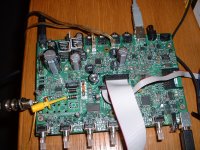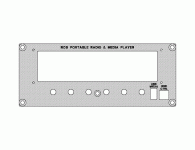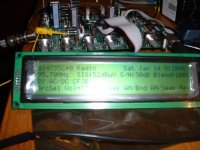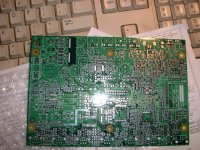The first part of his series -- the MPLX decoder is at:
http://www.kilmory.demon.co.uk/jlh/JLH_1.jpg
http://www.kilmory.demon.co.uk/jlh/JLH_2.jpg
http://www.kilmory.demon.co.uk/jlh/JLH_3.jpg
http://www.kilmory.demon.co.uk/jlh/JLH_4.jpg
I have not been able to locate the remainder of the articles.
http://www.kilmory.demon.co.uk/jlh/JLH_1.jpg
http://www.kilmory.demon.co.uk/jlh/JLH_2.jpg
http://www.kilmory.demon.co.uk/jlh/JLH_3.jpg
http://www.kilmory.demon.co.uk/jlh/JLH_4.jpg
I have not been able to locate the remainder of the articles.
Thanks for the information, see if we can find the front end & IF schematics.
To test for transmitter distortion, you can get a HP 8901A modulation analyzer. I bought one on eBay. We used these back in the day at Motorola for 2-way radio testing. The 8901A was a very expensive piece of gear back in the day, now you can get them for around $100, which is a steal. Shipping costs are higher than the unit cost. If you do buy one, try to get one with the built-in calibrators & a 10MHz reference oven. As a SG, I purchased a HP 8656B. It does not have stereo modulation capabilities, but that can be an external device connect to the ext. modulation input. There are a few designs on the net for a stereo modulator.
Regards
Rick
To test for transmitter distortion, you can get a HP 8901A modulation analyzer. I bought one on eBay. We used these back in the day at Motorola for 2-way radio testing. The 8901A was a very expensive piece of gear back in the day, now you can get them for around $100, which is a steal. Shipping costs are higher than the unit cost. If you do buy one, try to get one with the built-in calibrators & a 10MHz reference oven. As a SG, I purchased a HP 8656B. It does not have stereo modulation capabilities, but that can be an external device connect to the ext. modulation input. There are a few designs on the net for a stereo modulator.
Regards
Rick
Rick, I checked on ebay and it seems you are right about the low prices of that HP gear. I'll be monitoring them for sale in the UK because the postage from US does cost as much as the item itself.
The front end is a ready built ALPS unit from Japan I think, and is used as is, unmodified. From this, the output goes into a small IF amp board consisting 3 transistors and 4 ceramic filters. This then goes into the CA3189 board with the JLH VCO arrangement, then into the JLH sample and hold stereo decoder. I had searched the web, and could not find the published schematic for the IF and VCO parts.
David.
The front end is a ready built ALPS unit from Japan I think, and is used as is, unmodified. From this, the output goes into a small IF amp board consisting 3 transistors and 4 ceramic filters. This then goes into the CA3189 board with the JLH VCO arrangement, then into the JLH sample and hold stereo decoder. I had searched the web, and could not find the published schematic for the IF and VCO parts.
David.
Alps, front end, well that explain the sensitivity issue. So it is a varactor FE and how is the tuned freq displayed? I have an old ETI article from JLH as well, probably pre-dates your updated version. Same sort of setup, used a CA3089 if I recall, oh ya, learnt how to wind that quad coil. I can asist you in designing a new, more sensitive front end. I have a whole folder on this stuff.Need equipment however, I guess that i why I never got the job done. Out of date however, you will never get to the performance & features of a Si4735. This part cost <10$, it is fantastic technology. I'd say my Si4735 sensitivity, channel selection, is equiv to the tuner in my Pioneer SX-950. The Si4770 will probably better the tuner in the SX-1250, all for a couple bucks. It makes no sense to me to hold onto the old technology, it is nostelga/history. I place my complete stereo besides a spare SX-950 tuner unit, I scratch my head saying wow, this is where we have come in 30 years. Don't want to discourage you, but want to make sure you are aware of todays technology. I would appreciate, for someone to help me write code for my tuner/stereo
Rick
Rick
Last edited:
Test Equipment
I bought a HP 8656B for spare parts. I had it shipped from Israel to Canada. I think I paid $100US and it cost about the same to courier it. I have a near complete spare parts bin. I bought the 8656B unit locally, paid around $300 I think, AM mod was not working, it was a unit from Motorola, it was a unit that I cal'd back in the 80's, can you believe. Fixed the AM problem, dead 10-bit DAC, MC3410L . I got some free service manuals, 2 binders, since they were throwing them away, they had so many of them, most tech benches needed one to test the 2-way radios that were being mfgd. Service manuals are free at Agilent BTW. Great units, gotta know what your doing to fix them however. I wonder if there is a forum for fixing old HP stuff That's it for now.
That's it for now.
Take care
Rick
I bought a HP 8656B for spare parts. I had it shipped from Israel to Canada. I think I paid $100US and it cost about the same to courier it. I have a near complete spare parts bin. I bought the 8656B unit locally, paid around $300 I think, AM mod was not working, it was a unit from Motorola, it was a unit that I cal'd back in the 80's, can you believe. Fixed the AM problem, dead 10-bit DAC, MC3410L . I got some free service manuals, 2 binders, since they were throwing them away, they had so many of them, most tech benches needed one to test the 2-way radios that were being mfgd. Service manuals are free at Agilent BTW. Great units, gotta know what your doing to fix them however. I wonder if there is a forum for fixing old HP stuff
Take care
Rick
Given the ready-built front end in the JLH tuner, one could consider using a 'vintage' tuner and gutting everything after the front end. For example, the Dynaco FM-5 has a decent tuner with good front end and can be had on eBay for <$100. Just replace the IF onward.
It will be interesting to see the entire JLH schematic. One thing I'm cautious about with British tuners is that they often don't fare well in the crowded US broadcast spectrum due to poor adjacent/alternate-channel selectivity -- something that is apparently not as big a problem in the UK (or at least wasn't for years).
It will be interesting to see the entire JLH schematic. One thing I'm cautious about with British tuners is that they often don't fare well in the crowded US broadcast spectrum due to poor adjacent/alternate-channel selectivity -- something that is apparently not as big a problem in the UK (or at least wasn't for years).
I was thinking along similar lines, but say, taking a NAD4020 and taking out the quad coil, and replacing it with the VCO by JLH. I just might try this to see how it affects the sound/performance. I'm guessing that the harmonic distortion is not the definitive improvement, but rather another type, perhaps IM, phase distortion or some other artifact.
I also have some Arcam tuners from just after this period, which also use the CA3189 but using the LM4500 as decoder, and these may also be a good target for the JLH VCO too.
I also have some Arcam tuners from just after this period, which also use the CA3189 but using the LM4500 as decoder, and these may also be a good target for the JLH VCO too.
CA3189/LM4500, brings back memories, I still have some of these parts.
Considering that in Europe, the channel spacing is 100KHz, deviation is 50KHz,one would think that the filters need to be somewhat sharper and less BW than what is required in North America, that and the 50us deemphasis.
Cheers
Rick
Considering that in Europe, the channel spacing is 100KHz, deviation is 50KHz,one would think that the filters need to be somewhat sharper and less BW than what is required in North America, that and the 50us deemphasis.
Cheers
Rick
FM deviation in Europe is 75kHz. Although 'channels' may appear on any multiple of 100kHz the frequency planning means that local signals are unlikely to appear within less than about 400kHz (and usually much more - the original BBC stations were spaced 2.2MHz apart). The usual recommendation for Europe is 180kHz IF bandwidth for mono and around 280kHz for stereo.
I think our 50us deemphasis gives slightly higher noise and slightly lower distortion than 75us.
I think our 50us deemphasis gives slightly higher noise and slightly lower distortion than 75us.
FM deviation in Europe is 75kHz. Although 'channels' may appear on any multiple of 100kHz the frequency planning means that local signals are unlikely to appear within less than about 400kHz (and usually much more - the original BBC stations were spaced 2.2MHz apart). The usual recommendation for Europe is 180kHz IF bandwidth for mono and around 280kHz for stereo.
I think our 50us deemphasis gives slightly higher noise and slightly lower distortion than 75us.
In North America, or at least in the Toronto, Canada area, the FM band is near full capacity, I receive signals at regular 200KHz spacings. I even receive signals on the same frequency in certain atmospheric conditions. This becomes a problem for some stations, expecially if you have a omni-directional antenna. I receive signal from both the US and Canada. I am using a large fringe Yagi mounted on a 40ft tower with a amplifier on the top of the mast.
Not sure why you think that I can not use the HP8656B SG to test the Si4735 tuner for S/N,THD using 50 or 75 KHz deviations, with deemphasis setting of either 50 or 75uS? Can you explain why?
Rick
In North America, or at least in the Toronto, Canada area, the FM band is near full capacity, I receive signals at regular 200KHz spacings. I even receive signals on the same frequency in certain atmospheric conditions. This becomes a problem for some stations, expecially if you have a omni-directional antenna. I receive signal from both the US and Canada. I am using a large fringe Yagi mounted on a 40ft tower with a amplifier on the top of the mast.
Not sure why you think that I can not use the HP8656B SG to test the Si4735 tuner for S/N,THD using 50 or 75 KHz deviations, with deemphasis setting of either 50 or 75uS? Can you explain why?
Rick
First, comments on channel spacing. You likely know that most government authorities, like the FCC in the US, assign FM channels based on typical receivers, like those in cars. If you have a super duty tower mounted FM Yagi (or log periodic) long boom antenna rig, of course you can receive more distant stations than a typical car. And you will have problems with adjacent and co-channel stations. Channel assignments in the US usually allow for 400kHz spacing. This spacing allows the US HD digital FM system, which intrudes into adjacent channels, to work OK. But it's a pain for the guys with great tuners and antennas trying to DX.
On to test gear. The HP 8656B is a nice low phase noise signal generator, but not that great for modern stereo FM tuner testing. The bandwidth on the FM modulation is not enough for phase linear stereo composite signals, limiting the separation. In this case, you need flat phase response to 53KHz.
And the HP 8656B FM modulation circuit is not super linear, meaning you can't generate low distortion test signals. I have not looked at the spec recently, but if it is 0.5% or 0.3% THD, that's probably right. The best dedicated FM stereo generators with FET linearized FM modulation circuits can easily go to 0.03% or lower THD, 0.01% is typical in the best units.
I own 4 of the better FM stereo generators, including the Sound Technology ST-1020A, Panasonic VP8122A, Meguro MSG-2161, and RE 104 driven by an HP 8904A with options for FM Composite output. All of these get to way better than 50dB FM stereo separation, and way better than 0.03% distortion at 100% modulation.
Last comment - the Silicon Labs chips are for car radios. They are a single chip solution, but nowhere even close to the best vintage FM tuners for reception options, stereo separation, distortion, and dynamic range.
Look closely at the specs, and compare to, say Yamaha TX-1000, Denon TU-800, Kenwood KT-990, etc. And with simple ceramic filter mods, selectivity is easily modified using hand matched and sorted 180, 150, or 110 kHz Murata ceramic filters. These fairly simple selectivity filter mods can turn these tuners into unmatched FM DX machines.
For sound quality, mostly all of our FMTuners members agree that certain tube tuners, like those from Sherwood, Scott, Fisher, can best the solid state models provided you have a good antenna and signal. Sorry to get into this a bit long, but been doing this for a good while, and wanted to share some extended thoughts.
Bob
FM Tuners
Hi Bob,
Nice to see you following this thread. Good information and explanations for all of us.
I have not done any measurements on the Si4735 radio thus far. Actually no reason to, other that out of interest. I have however done a comparison to the Pioneer SX-950 tuner. The Pioneer tuner is probably one of the better ones, for the day, although a SX-1250 tuner would be one step better.
By scanning the dial, I see that the adjacent ch selectivity in the Si4735 is not as good as the Pioneer, sensitivity wise, it is on par. Variable stereo blend, sliding LP filtering, selectable IF bandwidth are all excellent features, near impossible to do in the analog domain. Maybe one of those Magnum Dynalab ones maybe better.
I will however try out the newer Si4770 part this winter and see what improvement that they have made, stay tuned, for that. The sensitivity on paper for the Si4770 part is remarakble. Want to check out the selectivity however. Hard to beat a $5 piece of silicon.
Car radio FM tuners seem to be driving the market, they do have some obsticles to contend with such as muti-path, something that a DSP based tuner, would excel at and an anlaog tuner would probably suffer.
After using the Si4735, well I can put the Pioneer to bed and no need to find a SX-1250 or anything else, once I get the Si4770 going.
Yes the ole HP8656B was never designed for ultra low distortion FM modulation. I liked this model since it was dear to my heart in the Motorola days. I used to cal/fix these things.
I have a HP8901A as well & have made the THD measurement on the 8656B. Even if I use the Amber DA set as a external modulation source, it will never go below 0.1%, which ain't bad for what I am doing. Of course I wish I had better gear but I am doing it as a hobby and not professionally.
Cheers
Rick
Hi Bob,
Nice to see you following this thread. Good information and explanations for all of us.
I have not done any measurements on the Si4735 radio thus far. Actually no reason to, other that out of interest. I have however done a comparison to the Pioneer SX-950 tuner. The Pioneer tuner is probably one of the better ones, for the day, although a SX-1250 tuner would be one step better.
By scanning the dial, I see that the adjacent ch selectivity in the Si4735 is not as good as the Pioneer, sensitivity wise, it is on par. Variable stereo blend, sliding LP filtering, selectable IF bandwidth are all excellent features, near impossible to do in the analog domain. Maybe one of those Magnum Dynalab ones maybe better.
I will however try out the newer Si4770 part this winter and see what improvement that they have made, stay tuned, for that. The sensitivity on paper for the Si4770 part is remarakble. Want to check out the selectivity however. Hard to beat a $5 piece of silicon.
Car radio FM tuners seem to be driving the market, they do have some obsticles to contend with such as muti-path, something that a DSP based tuner, would excel at and an anlaog tuner would probably suffer.
After using the Si4735, well I can put the Pioneer to bed and no need to find a SX-1250 or anything else, once I get the Si4770 going.
Yes the ole HP8656B was never designed for ultra low distortion FM modulation. I liked this model since it was dear to my heart in the Motorola days. I used to cal/fix these things.
I have a HP8901A as well & have made the THD measurement on the 8656B. Even if I use the Amber DA set as a external modulation source, it will never go below 0.1%, which ain't bad for what I am doing. Of course I wish I had better gear but I am doing it as a hobby and not professionally.
Cheers
Rick
I have not done any measurements on the Si4735 radio thus far. Actually no reason to, other that out of interest. I have however done a comparison to the Pioneer SX-950 tuner. The Pioneer tuner is probably one of the better ones, for the day, although a SX-1250 tuner would be one step better.
By scanning the dial, I see that the adjacent ch selectivity in the Si4735 is not as good as the Pioneer, sensitivity wise, it is on par. Variable stereo blend, sliding LP filtering, selectable IF bandwidth are all excellent features, near impossible to do in the analog domain. Maybe one of those Magnum Dynalab ones maybe better.
Hi Rick, I am impressed you've got the Si4735 working, it's a decent project.
I have a portable here that uses the same series chip, the Tecsun PL-606, which sells for about $49. USD. It allows for using an external 75 ohm antenna, and has a stereo output. So I hooked to my roof mounted 9 element FM antenna, and compared it to some of my better tuners. It did well, especially for selectivity. But was not as good as my best FM tuners for sensitivity, and sound quality. For a portable, though, the Tecsun PL-606 is a great little portable FM radio, especially for its size, and I use it a lot.
The Pioneer units you reference above are receivers, which usually were not as good as the top line dedicated Pioneer tuners, i.e. TX-9500II or TX-9800 from the same time frame. The TX-9500II/TX-9800 both have selectable width IF filters (wide and narrow) and so do many other top FM tuners. Some, like the better Yamaha tuners (but there are many others) have 3 or more IF bandwidths, stereo blend, and so on.
You can read the reviews of the best ones here at our website -
Tuner Information Center - Vintage Stereo Tuners
The prices for many of the best FM Tuners are very reasonable used, especially when you consider what they sold for new.
And sadly, very few companies make really good FM tuners equivalent to the best ones from 10-30 years ago. The few units that are available sell for absurdly high prices, starting well over $1,000.00 USD. Since you can buy some of the best ones used for under $200., most people go that way if they want the best performance and sound quality.
FM tuners
Hi Bob,
Working on the Si4735 was a fun learning experience for me. See attached pictures of the portable tuner/media player.
I wonder what the Si4735 would sound like with an external DAC (I2S output)? I guess that I will only find out if I give it a go, yet another project . This is what I was planning for my tuner/pre-amp project, but it got a bit much, so I scaled it down a fair bit to get my programming experience level up to snuff.
. This is what I was planning for my tuner/pre-amp project, but it got a bit much, so I scaled it down a fair bit to get my programming experience level up to snuff.
Regards
Rick
Hi Bob,
Working on the Si4735 was a fun learning experience for me. See attached pictures of the portable tuner/media player.
I wonder what the Si4735 would sound like with an external DAC (I2S output)? I guess that I will only find out if I give it a go, yet another project
Regards
Rick
Attachments
Last edited:
Hi guys,
although this thread is already a bit outdated, I have a question regarding the pre-emphasis / de-emphasis thing.
To my knowledge this comes from the early (FM-)days when nobody spent any thought about stereo.
Then is was a good idea to emphasise the higher frequencies before they get transmitted and to deemphasise them after demodulation.
In stereo-transmissions we get the (higher) noise from the difference-channel mixed in anyway and it influences the highest as well as the lowest frequencies in the same way.
Thus I belive that emphasis/deemphasis is just important for compatibility but not for noise-reduction in stereo-transmissions.
Therefore I would not expect a big difference between 75µs or 50µs deemphasis at all (as long as there are no overmodulation or limitation-effects).
May be I am wrong?
Let me know how you think.
HH
although this thread is already a bit outdated, I have a question regarding the pre-emphasis / de-emphasis thing.
To my knowledge this comes from the early (FM-)days when nobody spent any thought about stereo.
Then is was a good idea to emphasise the higher frequencies before they get transmitted and to deemphasise them after demodulation.
In stereo-transmissions we get the (higher) noise from the difference-channel mixed in anyway and it influences the highest as well as the lowest frequencies in the same way.
Thus I belive that emphasis/deemphasis is just important for compatibility but not for noise-reduction in stereo-transmissions.
Therefore I would not expect a big difference between 75µs or 50µs deemphasis at all (as long as there are no overmodulation or limitation-effects).
May be I am wrong?
Let me know how you think.
HH
Last edited:
- Status
- This old topic is closed. If you want to reopen this topic, contact a moderator using the "Report Post" button.
- Home
- Source & Line
- Analogue Source
- John Linsley Hood FM tuner article/s



